
Strong Women in Comics, Part 1
The Traditional "Good Girls"
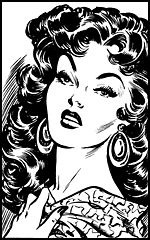 This is the first page in my series on the trend I see today towards more and better portrayals of strong women in the comics, specifically the portrayal of strong women, women in the roles more often filled by men. Such portrayals aren't entirely new, but I do see them as undergoing something of a renaissance. This page is devoted to the ancestresses of todays strong women, the "Good Girls" of the golden age of comics.
This is the first page in my series on the trend I see today towards more and better portrayals of strong women in the comics, specifically the portrayal of strong women, women in the roles more often filled by men. Such portrayals aren't entirely new, but I do see them as undergoing something of a renaissance. This page is devoted to the ancestresses of todays strong women, the "Good Girls" of the golden age of comics.
Good Girl comics are a genre that go back to World War II and the glory days of comic books. The phrase is generally used to refer to the whole class of glamorous heroines whose portrayal owes a lot to the pin-up tradition of cheesecake. It originally contrasted them with the Femme Fatales, the seductive villainesses like the Dragon Lady. Today's contrast is with the "Bad Girls" that I'll be covering in part 2. Whereas the Bad Girls are "women with an attitude", what the Good Girls have is spunk. Where the Bad Girls are nearly naked or dress in fetish outfits, the Good Girls dress with the provocative sexiness of 40's cheesecake. The Bad Girls are avengers. The Good Girls were adventuresses, heroines, sidekicks or girls who just naturally fall into, and escape from, trouble.
 Many of the Good Girls were super-heroes, but others came from a wide range of genres. Classic Good Girls include Sheena, the Jungle Queen; Seniorita Rio, Queen of Spies; Flamingo, the Gypsy Gal; pilots like Flying Jenny and Sky Girl; as well as superheroes like Mysta of the Moon, The Phantom Lady and Lady Luck.
Many of the Good Girls were super-heroes, but others came from a wide range of genres. Classic Good Girls include Sheena, the Jungle Queen; Seniorita Rio, Queen of Spies; Flamingo, the Gypsy Gal; pilots like Flying Jenny and Sky Girl; as well as superheroes like Mysta of the Moon, The Phantom Lady and Lady Luck.
Sheena and the Phantom Lady are often taken to be the archetypes of the Good Girl genre, although characters like Flamingo and Seniorita Rio should not be forgotten. Sheena's adventures were first published in Europe the year before Superman's debut. She was created in 1937 when the Universal Phoenix Syndicate, Jerry Iger and Will Eisner's studio, was asked to do a knock-off of Tarzan. Rather than do a straight knock-off, they decided to make their lead character a jungle heroine, and Sheena was born. She was beautiful, athletic, smart and a natural leader. She rescued men and had a male sidekick, not the other way around.
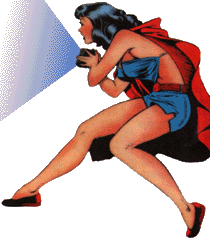 The Phantom Lady enjoyed two separate careers in comics published by two different companies. Like many of the characters created by Jerry Iger's studio and its spin-offs, the Phantom Lady was owned by the studio and not the publisher, and so after she was dropped by Quality, Fox brought her back in a new costume, but otherwise unchanged. In her Quality incarnation her costume consisted of a backless yellow leotard or swimsuit and a green cape. Fox changed that to a blue halter-top and tap pants combo and a red cape. In both cases she carried a "black light", sort of a flashlight that projected darkness instead of light, and wore no mask, yet was unrecognized even by her detective boyfriend.
The Phantom Lady enjoyed two separate careers in comics published by two different companies. Like many of the characters created by Jerry Iger's studio and its spin-offs, the Phantom Lady was owned by the studio and not the publisher, and so after she was dropped by Quality, Fox brought her back in a new costume, but otherwise unchanged. In her Quality incarnation her costume consisted of a backless yellow leotard or swimsuit and a green cape. Fox changed that to a blue halter-top and tap pants combo and a red cape. In both cases she carried a "black light", sort of a flashlight that projected darkness instead of light, and wore no mask, yet was unrecognized even by her detective boyfriend.
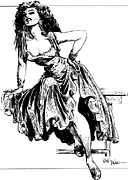 |
Some of the Phantom Lady's notoriety is due to the fact that Dr. Frederic Wertham used the cover of one of her comics as an example of sexual bondage in his book Seduction of the Innocent. While it is true that she is tied up on the cover and, thanks to Matt Baker's artwork looks quite fetching, I will quibble at least a little with the characterization. Dr. Wertham viewed comics as a major influence in the corruption of the youth of the 50's, thus when he looked at a comic he saw it in terms of sexual perversion, graphic violence, lawlessness, drugs and such.
In heroic adventure fiction, heroes and villains get into serious conflict. If the hero wins every encounter, the suspense and the heroism are lost. Thus the villain must win some of the encounters along the way. The hero can't be killed or the story ends, so the villain tends to capture rather than kill the hero. But, due to the double standard that says anything involving a woman must be sexual at its heart, if the hero that is captured is a woman, her confinement becomes bondage. Had the villain killed the Phantom Lady, the story would have ended, so she must either be incapacitated or restrained. Had the villain beaten her senseless, it would have been "graphic sexual violence". If the villain were a woman, the bondage or sexual violence becomes lesbian bondage or violence.
 It is certainly the case that Good Girl art, such as the Phantom Lady owed a good deal of its appeal to the good looks and sex appeal of the women it featured. Nonetheless, I feel that our view of these books as primarily sexual comes as much from how its detractors and more recent fans both, have portrayed it. To illustrate, let's contrast a few different portrayals of the Phantom Lady. First there's the picture by Baker, shown above (an in a smaller version here, to the right). This picture is from an interior panel and shows the Phantom Lady in action. She's rather scantily clad in the Fox blue and red costume, but there's nothing overtly sexual about the picture.
It is certainly the case that Good Girl art, such as the Phantom Lady owed a good deal of its appeal to the good looks and sex appeal of the women it featured. Nonetheless, I feel that our view of these books as primarily sexual comes as much from how its detractors and more recent fans both, have portrayed it. To illustrate, let's contrast a few different portrayals of the Phantom Lady. First there's the picture by Baker, shown above (an in a smaller version here, to the right). This picture is from an interior panel and shows the Phantom Lady in action. She's rather scantily clad in the Fox blue and red costume, but there's nothing overtly sexual about the picture.
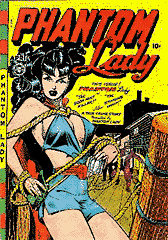 Next we have the cover of Phantom Lady #17, again by Matt Baker. This, if I recall correctly, is the same cover that Dr. Wertham used to illustrate bondage in comics in Seduction of the Innocent. The cover shot is a good deal sexier than the interior shot above. This is quite in keeping with the traditions of the pulps and comics of the day, where the covers were often spiced up as compared to the actual content of the magazine. In it, Baker has shown the Phantom Lady with a more deeply plunging neckline than in most of the interior art, and used a cheesecake pose. This is perhaps the sexiest cover ever to appear on the Phantom Lady comic, and would no doubt be well remembered even without Dr. Wertham's reference.
Next we have the cover of Phantom Lady #17, again by Matt Baker. This, if I recall correctly, is the same cover that Dr. Wertham used to illustrate bondage in comics in Seduction of the Innocent. The cover shot is a good deal sexier than the interior shot above. This is quite in keeping with the traditions of the pulps and comics of the day, where the covers were often spiced up as compared to the actual content of the magazine. In it, Baker has shown the Phantom Lady with a more deeply plunging neckline than in most of the interior art, and used a cheesecake pose. This is perhaps the sexiest cover ever to appear on the Phantom Lady comic, and would no doubt be well remembered even without Dr. Wertham's reference.
 Our third illustration is by Adam Hughes for the cover of a recent trade paperback featuring reprints of the Golden Age Phantom Lady comics. Hughes has clearly based this cover on the famous Phantom Lady #17. Our heroine is in a very similar pose and again threatened by an underworld thug. You'll note that he's further abbreviated the outfit, lengthened the slit up the hip of the tap pants, and made the neckline even more extreme. Her figure is also somewhat more full and round in keeping with the current esthetic. Nostalgia and Hughes' own style have romanticized the Golden Age cover a bit, and certainly not lessened its sex appeal. It does retain a good deal of the cheesecake innocence, however.
Our third illustration is by Adam Hughes for the cover of a recent trade paperback featuring reprints of the Golden Age Phantom Lady comics. Hughes has clearly based this cover on the famous Phantom Lady #17. Our heroine is in a very similar pose and again threatened by an underworld thug. You'll note that he's further abbreviated the outfit, lengthened the slit up the hip of the tap pants, and made the neckline even more extreme. Her figure is also somewhat more full and round in keeping with the current esthetic. Nostalgia and Hughes' own style have romanticized the Golden Age cover a bit, and certainly not lessened its sex appeal. It does retain a good deal of the cheesecake innocence, however.
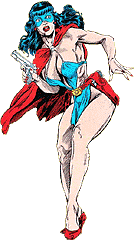 Our final illustration isn't, properly speaking, the Phantom Lady. Rather, it is Bill Black's character the Blue Bulleteer, a character he based directly on the Phantom Lady. In adapting the character, Black has made the costume even skimpier, replacing the tap pants with a loin cloth, and using about half the fabric as either of the other two for the top. He has also exaggerated her figure substantially, making her considerably more buxom and narrower in the waist. Finally, he's fastened her cloak with a skull-shaped clasp and armed her with a .45 caliber pistol in place of the non-violent black light ray. As we will see in part 2, the addition of dark occult motif and a lethal weapon, along with the minimal costume and highly exaggerated figure are all shifts in the direction of the Bad Girls.
Our final illustration isn't, properly speaking, the Phantom Lady. Rather, it is Bill Black's character the Blue Bulleteer, a character he based directly on the Phantom Lady. In adapting the character, Black has made the costume even skimpier, replacing the tap pants with a loin cloth, and using about half the fabric as either of the other two for the top. He has also exaggerated her figure substantially, making her considerably more buxom and narrower in the waist. Finally, he's fastened her cloak with a skull-shaped clasp and armed her with a .45 caliber pistol in place of the non-violent black light ray. As we will see in part 2, the addition of dark occult motif and a lethal weapon, along with the minimal costume and highly exaggerated figure are all shifts in the direction of the Bad Girls.
This is significant because Black's company, Americomics (also known as AC) and their comics, the Fem Force and Good Girl Art Quarterly are among the major proponents and modern interpreters of Good Girl art. His version of Golden Age characters such as Miss Victory and the Phantom Lady are all that many people know. The inaccuracies in his memory and portrayal are passed on to others. It's a small thing, but in Good Girl Art Quarterly #6, he described Baker's Phantom Lady as wearing high heals and having a V-neck the plunged all the way to waist right next to an illustration he himself drew based on one of Baker's pictures which showed her in flats with a neckline that drops only to about mid-breast level. It is the Blue Bulleteer who wears high heals and a V that plunges to the belt. I suspect that because the Phantom Lady was quite sexy for her day, Black thinks of her as if she were extreme not by her day's standards, but ours.
We need to keep a sense of perspective here as elsewhere. Yes, there were definite sexual elements in the portrayal and popularity of the Good Girl comics, but that was only one element, and often not the most important. The Good Girls appealed to a lot of people and for a lot of reasons. Today the vast majority of comicbook readers are males, especially younger males, but in the 40's the audiences were much larger and much more diverse.
Some of these characters were aimed at a male audience, some a female audience and some a general audience. Wonder Woman was created specifically to appeal to girls, and as you can tell from the ads in the books or features like paper dolls, other female characters like Mary Marvel and Flying Jenny were as well. On the other hand, the Phantom Lady probably wouldn't have dressed the way she did if she were aimed at a solely female audience. Still other characters, like Sheena, were created for a general audience. She was an elaboration on the Tarzan theme, but done as a woman to make her different and original. Her outfit was no more revealing than his own, and perhaps less so.
We tend to think of the early decades of 20th century as an unenlightened time when women were only portrayed as subordinate to men. Characters like Sheena or Garbo's 1933 portrayal of Queen Christina help to remind us that the reality is somewhat more complex. Their man-like strengths make them exotic and alluring. They are the exceptions that "prove the rule", in the original sense of that phrase. ("Prove" here means to test the rule, to show us its boundaries, not to establish its truth in a scientific or legal sense.) Yes, most portrayals of women were as subordinate. Most women in adventure fiction were there to be rescued -- at times little more than a reward awaiting the hero -- but strong portrayals of women were also there to be found, and they were attractive and popular. In the 30's and 40's there were many instances of strong female characters, both Femmes Fatale and Good Girls.
With this background i the Good Girl tradition, we turn now to their modern-day opposite numbers, the unfortunate genre of the Bad Girls in part 2.
|| Previous | Comics Page | JimB's Home Page | Next ||